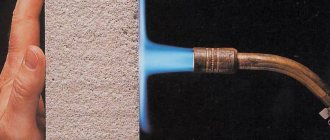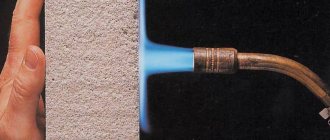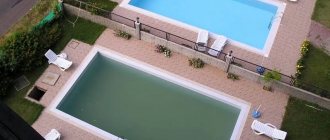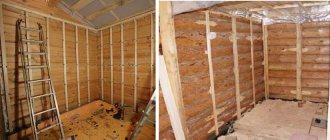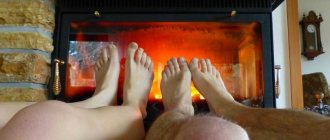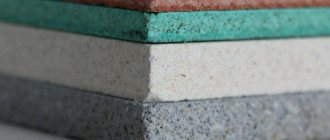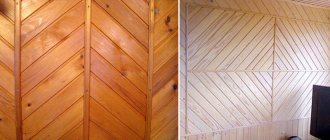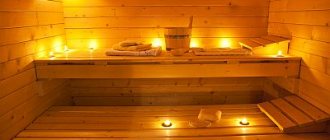When firing a stove or igniting a fireplace, their body becomes very hot, transferring this temperature to the surrounding surfaces. In accordance with fire safety techniques, it is necessary to insulate the furnace body from adjacent surfaces using fire-resistant materials if a safe distance is not maintained. This is a distance equal to 30 cm for a brick stove, more than 1 meter for a metal stove and 70 cm for a metal-lined stove. If it is impossible to dissipate heat naturally in a room (especially a small area), fire-resistant materials are used for the walls around the stoves.
Ways to increase fire resistance
To increase the fire resistance of walls and other structures in the house, they are coated with non-flammable substances, and fire-resistant materials are used for finishing. Products consisting entirely of inorganic substances or their predominant amount are known to be the most heat-resistant. Some mineral reagents are used as fire retardants.
There are a small number of organic compounds that are not flammable and do not support combustion. Some of the non-flammable organic solvents are even used in firefighting.
You can protect walls and structures from fire:
- using heat-resistant primer, pastes, plasters;
- painting walls with fire-resistant paints;
- pasting with heat-resistant wallpaper;
- installing sheets or slabs that do not react to fire;
- impregnating materials with fire retardants.
The decision to choose a fireproof material for walls should be made after assessing financial possibilities and discussing the project with craftsmen and designers . Reasonably chosen non-combustible finishing will help insulate the room and increase sound insulation.
Protective stainless steel sheets
This material is not cheap, but it is very reliable. Using it, you can protect not only the walls of the house, but also the basement when installing a solid fuel heating unit.
In order to protect yourself and create maximum protection, special fiberglass with thermal protective properties is placed under the stainless steel. Such a design will cope well with the function of protection against the slightest attempt at fire. The choice of substrate should be approached very carefully; you need to thoroughly inspect the product for the presence of phenolic resins, which release harmful substances when heated strongly.
Primary treatment with paste or plaster
Wall decoration, taking into account safety, can be carried out by combining several non-combustible materials. Each area of the room has its own characteristics. It can be located near stoves, fireplaces or at a distance.
The choice of wall finishing method depends on the number of storeys in the house, the method of laying electrical wiring, and the material from which the supporting structures are made.
Heat-resistant primary treatment of walls is appropriate in almost all cases. Compositions of primers, plasters, and special pastes, depending on the consistency, can be spread, sprayed, or sprayed. The thickness of the coating with non-flammable paste reaches 1 cm, with plaster - up to 4 cm.
The main feature of non-flammable finishing compositions is the absence of the usual Portland cement and quartz sand. Conventional cement, when hardened, forms calcium hydroxide, which, in the event of a significant increase in temperature during a fire, decomposes to oxide.
Under the influence of moisture or water flow, which happens when extinguishing a fire, the oxide swells due to hydration. The coating breaks and cracks.
As a result, fire can reach the base of the structure, the wall, and spread throughout the house. It becomes difficult to put it out. The formation of cracks is facilitated by the transformation of sand molecules from one modification to another, more voluminous.
Non-combustible materials for wall decoration include liquid glass, building gypsum, aluminous or pozzolanic types of cement. Special types of clays are used as aggregate, for example vermiculite, volcanic products such as pumice or tuff; fine fractions of expanded clay, metallurgical slag, power plant ash.
The compositions can be filled with mineral fibers, for example, kaolin wool. The most affordable option for non-combustible material for preparing walls is a mixture of “lean” clay available in the area with sulfite-yeast lye dissolved in water. The humidity of the room treated with such composites should not exceed 65%.
Requirements
Fireproof materials must reliably protect the home from any fires, withstand numerous heating-cooling cycles for a long time without deformation, and be environmentally inert so that no harmful substances enter the room when heated.
They must have:
- fire resistance sufficient to ensure safety;
- low thermal conductivity;
- constancy of shape and volume when heated;
- chemical resistance;
- slag resistance;
- low ability to absorb moisture;
- increased strength.
Furnace coating
Heated surfaces are also coated with special heat-resistant primers. The purpose of such treatment is not only and not so much protection from fire, but also to improve the adhesion of the subsequent layer of paint and reduce its consumption.
Thanks to the use of heat-resistant primer, the protection of radiators, metal fireplaces and stoves from corrosion processes is increased.
There are several types of non-flammable compositions based on glycol varnishes, phosphates, and silicates. When choosing a specific finishing material, you need to know exactly the maximum heating temperature of the surface. Heat-resistant primer for furnaces has restrictions on use, which are indicated in the accompanying documents.
Protective screens
Protective fireproof screens are special fire-resistant decorative panels designed to insulate the side walls of furnace structures; they are mounted at a distance of 1-5 cm from the furnace body. The screen differs from a fire-resistant sheet in its multi-layer structure.
By using such heat-resistant insulation material, you can significantly reduce thermal radiation. Screens made of cast iron and stainless steel are widely popular.
The polished mirror surface of the steel screen reflects heat, which is characterized by softer flows. The plates located inside the screen are connected using heat-resistant mastic, mortar adhesive, and sealant, which are characterized by high heat resistance.
Heat-resistant mastic has a fire-resistant composition that can withstand high temperatures - 1100°C or more. In addition, it is not afraid of moisture, has bactericidal properties, and can be used as a cladding.
On the market you can find not only side screens, but also front ones. Installation of such devices is carried out by attaching them to the floor near the stove; the screen itself is equipped with special legs. In addition to steel and cast iron screens, quite often users also give preference to brick structures that look like walls. They separate the furnace body from flammable areas.
Protective screen
Thermal paint application
Fire-resistant wall paint contains fillers and pigments. A non-flammable composition for wall finishing, after hardening, forms a film that performs protective and decorative functions. Thermal paint is an inorganic complex of alkali metal and silicon oxides.
Talc, special types of clay, and mineral fibers are used as fillers. There are two components offered for sale that must be combined and mixed before use. The resulting non-flammable mixture should be used within a maximum of 12 hours.
There is fire-resistant paint intended for interior surfaces, in particular walls, as well as for exterior coatings.
Description and purpose
Refractory materials (refractories) for furnaces are made from mineral raw materials and have the ability to retain their properties for a long time when heated, as well as when working in aggressive environments, without collapsing.
Fireproof materials, due to their special properties, not only protect premises from fire, but also prevent heat loss.
This led to their use for the construction of protective coatings during the construction of stoves and fireplaces in country houses, bathhouses, premium apartments , as well as for fire protection of chimneys and surfaces around them.
Types of heat-resistant wallpaper
For final finishing of the walls, you can use heat-resistant wallpaper. They are produced using several technologies. There are metallized roll materials that are made as follows.
The interlining, which is a product made from cellulose and synthetic fibers, is covered with thin aluminum foil. The top is coated with non-electrically conductive paint or embossed. Non-flammable wallpaper has interesting patterns and performs decorative functions. The material is durable.
Another type of non-flammable wallpaper is made from fiberglass. All components are of natural origin. The material washes well, has a beautiful appearance, and is suitable for premises of any purpose. The fire safety certificate confirms the high fire-retardant ability of non-combustible wallpaper.
additional characteristics
A sheet of metal, as well as a number of other fire-resistant coatings, must have certain properties and characteristics that will make operation as safe as possible.
Product marking:
- A parameter such as flammability is designated by the capital letter G. It varies from 1 to 4, where 1 is the minimum degree of flammability;
- The degree of flammability is marked B. Flammability is marked from 1 to 3. 1 is difficult to ignite;
- It is important to pay attention to the degree of smoke generation (D). Marking from 1 to 3;
- Toxicity (T) plays an equally important role. From one to four. 1 is the least toxic;
- Also, many products are marked with the letters RP, which indicates the degree of how quickly and in what quantity the flame spreads. They are designated by a numerical value from 1 to 4. 4 is the maximum degree of fire spread.
When purchasing, also pay attention to the product class (KM). The number 0 denotes various gypsum and cement mortars. 1 – these are natural minerals, ceramics, porcelain stoneware and bricks. Class 2 is given to non-flammable linoleum and self-leveling polymer coatings. The number 3 denotes carpets, linoleums, carpets and laminate. The most flammable and dangerous materials are those marked 4. These are cork floors, bags, and vinyl coverings.
A sheet of metal, the price of which depends on the thickness and dimensions, is also a reliable covering for floors or walls and is widely used for insulation work.
Fire resistant fabrics
Wall decoration can be done with classic drapery. The existing fireproof fabric, practically indistinguishable in appearance from conventional woven materials, allows you to embody any ideas of designers.
The material is made by weaving polymer fibers. Fire retardant impregnation gives the products non-flammable qualities. Fire-resistant woven materials are used for finishing the walls of any premises, car interiors; They are used to make professional clothing for firefighters, rescuers, and metallurgists.
Fire retardants can impart non-flammable properties to almost any material. The effect is due to the ability to absorb the thermal energy of the flame, spending it on melting the fire retardant additive. Plus, gases are released that do not support combustion.
Features of placing a refrigerator next to a gas stove
In order for a household appliance to work properly, it must be provided with a suitable microclimate. The technology provides for certain operating rules. It must operate at a suitable temperature.
Compliance with the rules of operation of the refrigerator is the key to the longevity of the device.
It is not advisable to place the refrigerator next to appliances such as a gas, electric stove or oven. If the unit is placed next to such equipment, then thermal insulation must be provided. This is necessary to prevent a fire hazard.
First of all, you need to study the instructions.
Before installing the refrigerator, you must read the operating instructions. It details the recommended distance between household appliances, which is required for normal cooling of the unit.
In small rooms, you need to carefully study all the options for the location of the necessary devices. Consider sun exposure, air circulation and heat. Before purchasing a refrigerator, you need to decide in advance on the location and size of the unit. After all, large dimensions often force owners to purchase a mini-stove or a small sink, which is inconvenient.
Because of the small kitchen, you have to buy smaller appliances than you would like.
Communications
New and well-laid pipes and good plumbing are the key to the absence of breakthroughs. In any case, make it possible to easily and quickly access the communications under the sink and install additional valves there so that in case of emergency the water can be quickly shut off in this particular area.
If the apartment uses gas, entrust the replacement of the hose and connection of the stove to a professional. If you decide to replace it yourself, lubricate the joints with soapy water to make sure there are no bubbles and no leaks.
Electrical is also very important. It is ideal to connect the entire kitchen to a separate machine, that is, isolate it from the rest of the wiring in the apartment. Many appliances, such as electric stoves and ovens, dishwashers, some microwaves and even kettles require a power cable. Be sure to consult with an electrician to understand which devices can be combined into one network, and which ones will lead to overload and the plugs will constantly be knocked out. Place external sockets away from the sink and stove.
Non-flammable foam decor
The same conditionally non-flammable polystyrene foam can be used to decorate the facade with various architectural elements. Figured decor made of foam plastic is very popular due to its aesthetic appearance and affordable cost. You can buy foam plastic products relatively inexpensively, and the visible result is comparable to what real stone decor looks like.
A significant advantage of expanded polystyrene is its low weight. It does not create a load on building structures, and in addition, it can be easily installed by one person. As for fire safety, high-quality material fully meets the requirements for fire resistance of building and finishing materials.
For the manufacture of facade decor, the above-mentioned high-density PPS F is used, which belongs to the group of low-flammable materials (group G1).
Consequences of her absence
The lack of wind protection for walls in a frame house leads to gradual destruction of the insulation. Thermal protection is also reduced, which leads to the need to additionally heat the home. But that's not all the problems. In the absence of wind protection, the tree suffers from temperature changes and moisture:
- Due to the increase in density from moisture, the tree begins to warp.
- When the frame “leads,” windows and doors are destroyed.
- Constant dampness leads to the formation of mold, which can make the house uninhabitable.
- At low temperatures, the water accumulated in the wood freezes and leads to rupture of its fibers, and, accordingly, to the appearance of cracks in the wood and deformation in the slabs.
About the consequences of missing or incorrect insulation in the video:
Proper wind protection at home is not mandatory, but an important element. It helps to avoid many problems that can be destructive not only to the structure, but also to the health of the residents. The presence of insulation will prevent mold and rot in the wood, keep the house warm and save money on utility bills.
Brief historical background
The need for fireproof materials arose early in the development of human culture, when fire appeared. Gradually they became the basis of blast furnaces, steel-smelting and other furnaces. In the middle of the 17th century, refractory bricks began to be produced in Russia. During the reign of Peter I, a larger number of them were made on the basis of Moscow clays.
The cladding of the walls around the stove should not only be heat-resistant, but also match the interior of your room
In the 19th century, fireproof production developed only at metallurgical plants, while in Germany it was organized back in 1810, and in Europe they were already producing fireproof products in full swing. With the entry of the bourgeois class into the economic arena and with the development of industry, Russian scientists also began to work in this direction, and in 1893 the Belokamensk, Bryantsevsky and Latninsky refractory clay factories appeared.
In 1929, research on the fire protection of building materials began to be carried out in research laboratories. Fire-resistant paints were invented for wood coatings and intumescent paints for metal. Methods and rules for treating wood with fire retardant compounds are described in SNiP Sh-V.7−69, and GOST 16363–76 established the use of heat-resistant materials for the stove.
Today, out of 212 countries in the world, only 35 can claim to have a refractory industry, and half of the world's production belongs to the CIS and the USA. The importance of refractories in the economy of our country is very great. Without them, the production of many materials, the construction of various thermal units and space exploration are impossible.
When are sheet fireproof materials used?
It is not always necessary to use protective materials, but only in cases where the fire-safe distance from the stove surface to flammable objects is not maintained. If the distance is large enough, the wood does not heat up enough to cause a fire.
Modern standards require that a brick stove be located at least 32 cm from the wall, a non-lined metal stove at least 1 m, and a lined metal stove at least 70 cm.
For a spacious room, such requirements are quite feasible. But in a small home steam room it is not possible to provide a distance of 1 m. Therefore, fire safety can only be achieved with the help of fire-resistant screens and cladding.
Windbreak technology
Before starting the installation of wind protection for a frame or wooden house, you should prepare everything necessary for this. Film or sheet material must be cut into fragments according to the drawn up diagram. The installation technology depends on the specific material chosen.
Installation of a diffuse membrane
The diffusion membrane must be installed correctly. This is important because permeability is one-way. Incorrect installation during installation will result in tasks not being completed.
To avoid installation errors, manufacturers of diffusion membranes paint the sides in different colors. Inscriptions, images and pictograms are applied to one side.
A diffuse membrane is installed on the outside of the wall. The clean side should be located towards the insulation, and the surface with the inscriptions and logo should be located on the outside. The materials are secured to the supporting frame using galvanized nails, staples or a construction stapler.
“Pie” of a frame wall using a windproof membrane
The installation sequence of the diffusion membrane is as follows:
- Determine the front side.
- Roll out the first strip along the wall, starting from the bottom. Both sagging and strong tension are unacceptable.
- Attach the membrane to the wooden frame. Cut off the rest with a knife.
- Roll out the second strip and overlap it with the first one.
- Perform similar actions until the wall is completely filled.
The final stage is to attach the slats to create a gap to ensure ventilation.
An example of installing a windproof membrane in the video:
Wall insulation with slabs
Before installing the tiled windbreak, you must ensure that all mounting surfaces are dry. Wind protection with slabs is installed after the building has been provided with thermal insulation.
The material should be cut into the appropriate number of sheets. Dowels are used to secure the sheet protection. The joints should be reinforced with mounting tape.
In the video about the features of installing OSB boards during the construction of a frame house:
